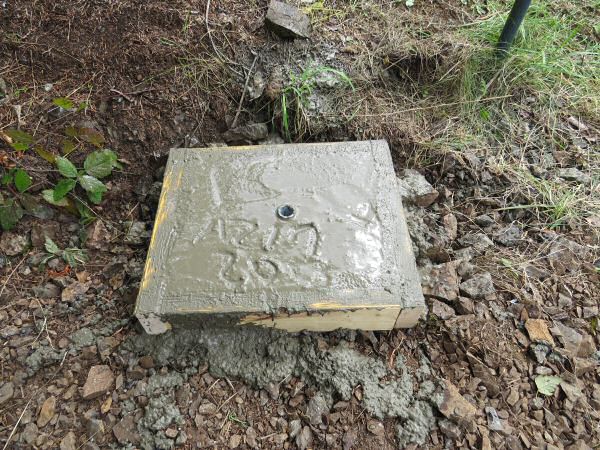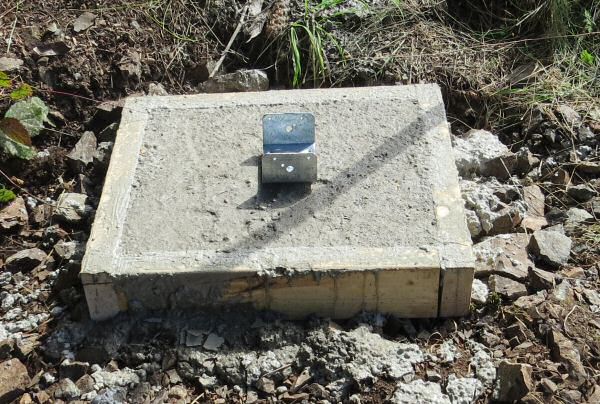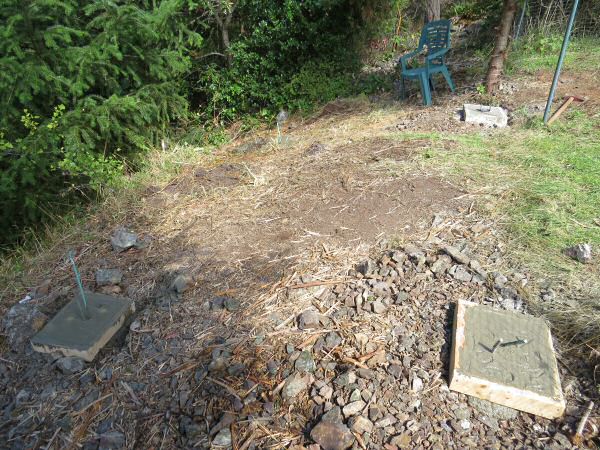GrowerNode™ is the name for our greenhouse and garden environmental sensing and control system. It is a browser based system for sensing and control of greenhouses, gardens and field operations. The 'Islander' is our small greenhouse design that we will use as a demonstration project.
In Part 2, we discussed the site prep and layout of the foundation; in Part 3 we'll cover the details of the concrete pour for the footings and columns.

Here's the first corner footing pour; this is the highest corner we consider to be 'datum', the point which all other locations are referenced to. We had our Logistics Co-ordinator Andy Mityok finger draw his initials with the year, to mark this propicious moment, while our Project Manager Stew Ludtke began planning the next step. We stopped for the day at this point to allow the concrete to harden overnight, so that we could be sure it won't move for the final precision alignment of the other 3 footings.
This was done very simply, by adding water to the premix in a wheelbarrow and carefully placing the concrete into the form with a shovel.
Meanwhile, our Research Analyst Connie Cromien McAdam is busy building a database of all the materials we are using, which we will make public once the project is finished.

The next day the concrete had hardened nicely, and we inserted the adjustable beam saddle that we will use at each corner to get the building perfectly level. These saddles sit on a threaded rod that we can put a large nut and washer on to make the height adjustable and are well worth the $5 they cost.
Shortly after we finished the pour on the previous day, we had a cloudburst and the heavy rain from Mother Nature created a mottled effect on the concrete, contributing to the artwork.

We finished up the concrete pour for the rest of the footings. It doesn't look like much, but we worked up a pretty good sweat mixing up the 6 bags of ready-mix it took to fill the forms. The positioning of the footings looks wonky, but that is just an optical effect from my wide angle camera lens. They are in fact lined up quite well; we worked to about a quarter inch tolerance re positioning.
The footings create a nice level platform to set up the column form tubes on; note the epoxy covered rebar that extends from the concrete that will stabilize and strengthen the columns. The short stubs are the tops of the long pieces pounded into the ground, and we are adding more rebar when the pier columns are poured - she ain't gonna move.
Tomorrow we'll set up the forms for the columns that the greenhouse will sit on. The columns will be approximately 2 feet high, so we figure we'll need about 3 more bags of pre-mix.
You can calculate the volume of the 24" high columns with this formula for cylinders:
V = Πr2 x H (read like this: Pi x radius squared x height)
V = 3.14 x 3" x 3" x 24"
V = ~678 cubic inches (the tilde character ~ means "approximately")
You also need to know the volume of the footings, which were made with 16" lengths of 2x6. They have an internal measurement of 16" x 13" x 3.5", so the volume is:
V = Length x Width X Height
V = 16" x 13" x 3.5"
V = ~728 cubic inches
Then you need to know the volume of concrete in the premix bags. The size of Quickrete bags we used are specified as 19" x 12" x 4", so the volume is:
V = Length x Width X Height
V = 19" x 12" x 4"
V = ~912 cubic inches
So, in our case, we had 4 identical footings (4 x 728 cu. in. = 2912 cu. in.), and 3 columns with an average height of about 24" (3 x 678 = 2,034 cu. in.), for a total volume of approximately 4,946 cubic inches. If you divide that by the volume of a bag (912 cu. in.), you get 5.4 (rounded up to 6) bags of concrete premix.
These calculations are not taking into account numerous factors:
- the size of the hole underneath the footings
- the leakage out of the form
- effect of water on the volume
- irregular shape of premix bags
In reality, it looks like we are going to use about 11 bags because we also decided to add center footings for the beams, after considering the weight of the thermal mass, soil and water storage we plan to use inside the greenhouse. This can add up to a lot of weight, and if anything, we want it over-built and stronger than it needs to be.
Tomorrow we'll set up the column forms and pour them, then we'll be ready to set up the foundation beams for the main structure.
GrowerNode™ Greenhouse Construction Index (The Islander):
Part 1: Greenhouse Construction: Introduction
Part 2: Greenhouse Construction: Site Prep & Footings Forms
Part 3: Greenhouse Construction: Foundation Concrete Footing Pour (you are here)
Part 4: Greenhouse Construction: Foundation Pier Column Setup
Part 5: Greenhouse Construction: Bubble Wrap Insulation re Floor Joist Modules
Part 6: Greenhouse Construction: Framing the Structure for Bubble Wrap vs Glass Walls
Part 7: Greenhouse Construction: Roof Module Installation
Part 8: Phase 1 Completed, Ready for Finishing Stain & Bubble Wrap Skin